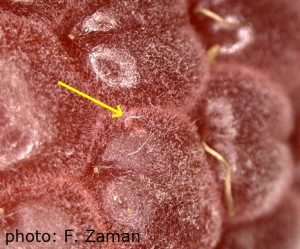
As of August 7, 2017, all of the 32 SWD trapping sites have caught SWD in 21 counties in New York. To prevent fruit infestation now, susceptible fruit crops need to be protected with an insecticide spray program or have already had exclusion netting in place. Reports are coming in from growers stunned by the level of damage that SWD can cause to their crops, especially blueberries and raspberries. Plantings have been closed.
As of August 10, on average, 200 SWD per trap are being caught in an unsprayed fall raspberry planting at the NYS Agricultural Experiment Station in Geneva, NY. Fruit samples from this planting have, on average, 8 larvae per fruit as found via salt flotation. Each collected fruit yielded a range of 0-8 eggs. These data provide evidence that high pressure from SWD builds during late summer, making it impossible to harvest susceptible fruit that is free of infestation during this time, unless an insecticide program or exclusion netting is in place.
Protect crops from SWD! (SWD hosts)
- late-summer-ripening raspberry, blueberry, blackberry, elderberry
- monitor for infestation in less susceptible fruits: ever-bearing strawberries, thin-skinned grapes, plums and prunes with salt flotation
Management tactics- (SWD management)
- timely insecticide sprays (berries) (tree fruit and grapes)
- rotate active ingredients
- weed management
- canopy management
- clean picking
- remove or spray dropped fruit
Read and follow insecticide label directions.
Find more about SWD on Cornell Fruit Resources SWD pages.
Please join me in thanking the Cornell Cooperative Extension (CCE) specialists who contributed time to the SWD trap network:
- Amy Ivy, CCE Eastern NY Horticulture Program (Clinton and Essex County traps)
- Bernie Armata, CCE Association of Herkimer County (Herkimer County traps)
- Dave Thorp and Jennifer Damon, CCE Association of Livingston County (Livingston County traps)
- Don Gasiewicz, CCE Association of Wyoming County (Wyoming County traps)
- Faruque Zaman, CCE Association of Suffolk County (Suffolk County traps)
- Janice Beglinger, CCE Association of Genesee County (Genesee County traps)
- Jim O’Connell, CCE Association of Ulster County (Ulster County traps)
- Juliet Carroll, Nicole Mattoon and Taylere Herrmann, CCE NYS IPM Program (Cayuga, Onondaga, Schuyler and Wayne County traps)
- Laura McDermott and Annie Mills, CCE Eastern NY Horticulture Program (Albany, Rensselaer, Saratoga and Washington County traps)
- Margaret Ball, CCE Association of Tioga County (Tioga County traps)
- Sharon Bachman, CCE Association of Erie County (Erie County traps)
- Stephanie Mehlenbacher, CCE Association of Steuben County (Steuben County traps)
- Tess Grasswitz, CCE Lake Ontario Fruit Program (Niagara and Orleans traps)







